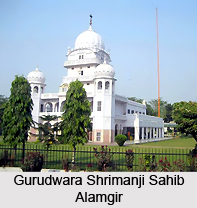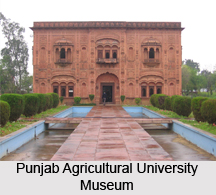Ludhiana City
 From being a small village called Meer Hota in 1481 to later Lodiana and now Ludhiana, the city has never been caught napping. From first to fourth century it was under the rule Yodhas and later came under the rule of Samudragupta. The original Ludhianavis started to settle here in the ninth century. These were the Rajputs from south and then the Turks and the Afghans who took the Bet area of Sutlej on lease from Mohammad Gami. Later, the Sidhus, Gills, Sandhus and the Grewals came from the jungles of Jagraon and camped here.
From being a small village called Meer Hota in 1481 to later Lodiana and now Ludhiana, the city has never been caught napping. From first to fourth century it was under the rule Yodhas and later came under the rule of Samudragupta. The original Ludhianavis started to settle here in the ninth century. These were the Rajputs from south and then the Turks and the Afghans who took the Bet area of Sutlej on lease from Mohammad Gami. Later, the Sidhus, Gills, Sandhus and the Grewals came from the jungles of Jagraon and camped here.
Sikandar Lodhi sent Yusaf and Nihang to stop the approaching Baloachs. They crossed Sutlej and after defeating Khokhars of Doaba, established Sultanpur Lodhi. Nihang stayed back at village Meer Hota as Naib. He changed the name of the village to Lodiana. Later, his grandson, Jalal Khan, built the Lodhi Fort there. His two sons Aloo Khan and Khijar Khan divided among themselves the area around the fort but were dethroned by Babur who even demolished Nihang`s tomb. That didn`t end the travails of this town. During Akbar`s reign, it was a tehsil along with Tihara.
Ludhiana is the textile center of India and a very rapidly growing town. In the field of agriculture, Ludhiana occupies a large grain market. Hero Bicycles, the world`s largest manufacturer of bicycles is based here. Christian Medical College Hospital of Ludhiana, established in 1895, was the first school of medicine in Asia. The world`s famous Punjab Agricultural University resides here. It has an excellent museum. Ludhiana accounts for 90% of the country`s woolen hosiery industry. Ludhiana is also famous for rural Olympics.
Gurudwara Shrimanji Sahib Alamgir
It is situated at a distance of 10 Km from Ludhiana.It is the place where the Muslim devotees Nabi Khan and Ghani Khan had carried Guru Gobind Singh to safety during the battle. Guru Gobind Singh (1666-1708), the last of the Sikh Gurus, transformed the pacifist Sikh sect into a martial community. He introduced rites of initiation into well-organised Sikh army known as the `Khalsa`. There is a tank where it is believed that the Guruji had shot an arrow into the parched earth to pierce a sub-terrain stream of water. A fair is held there in every December.

Pir-I-Dastgir shrine
The fort to the north-west of Ludhiana includes the shrine of Pir-I-Dastgir, also known as Abdul Kadir Galani which draws both Hindu and Muslim pilgrims.
Phillaur Fort
The fort was designed by Dewan Mohkam Chand, the brave general of Maharaja Ranjit Singh. It is police training center now.
Punjab Agricultural University Museum
The world famous, Punjab Agriculture University founded in 1962 is situated on the outskirts of the city. It is patterned after the Land Grant College of America. The Museum of Rural history of Punjab is on the University campus. The museum building resemble the traditional houses of rural Punjab. A 100 yard long path, flanked on both sides by water channels, leads to the finely carved doors of the museum. There are exhibits of old bronze utensils, farming equipment etc. Open from 9 am to 1.00 pm and 2 pm to 5 pm.
Christian Medical college
Established in 1895, Christian Medical College was the first school of medicine in Asia. This college has a partnership with CMC in Vellore. Both these colleges together form one of the South Asia`s major teaching and research hospitals.

Bilwanwali Masjid
Mosque of Kamal-ud-din Khan/Sarai Doraha on the main highway, dates back to Emperor Jahangir`s time. Rectangular in shape it has rooms and varandahs on all sides. Two great double storied gates are profusely decorated with coloured tiles and intricate brick carvings Bhir has the famous mosque built by Mohammad Ghori in 1911.
Famous Tombs
Mausoleum of Alawal Khan built during Shah Jehan`s reign is octagonal in shape, surmounted by double pear shaped dome. The tomb of Bahadur Khan has sloping walls Tomb of Husain Khan is 2 storied tomb.
Gurudwara Charan Kamal
This Gurudwara situated in village Machhiwara, 35 km from Ludhiana, commemorates the place where Sri Guru Gobind Singh had rested while fighting a guerrilla war against a massive Mughal force.
Gurudwara Nanaksar Jagraon
It is located 38 km from Ludhiana, a remarkable memorial of the Sikh Saint, Baba Nand Singh Kaleranwale. A five days fair is held here in his memory in August every year.
Culture of Ludhiana
Hindu festivals and celebrations such as Dasara and Diwali are as enthusiastically observed as are the birth and death anniversaries of the gurus and saints. To sikh community the festival of Baisakhi, celebrated in month of April, is of special significance because on this day in 1689 Guru Govind Singh organised the Sikhs into khalsa or `pure one`. In the countryside farmers start harvesting with great jubilation. The bhangra dance is common sight in the villages. Punjabi is the main language, while Hindi and English are also commonly used.

Getting There
There are many long distance direct train connections, linking Ludhiana to major centres in India. Daily bus service connect Ludhiana with Delhi and other towns in Punjab and neighbouring states.
Tourist Information
•Punjab Tourism Office, Chandigarh, Tel :- (0172)-704570.
•Punjab Tourist Information Office, Youth Hostel, Amritsar.
•Punjab Tourist Information Centre, Raja Sansi Airport, Amritsar.
For complete business listing of Ludhiana visit Ludhiana Yellowpages



















